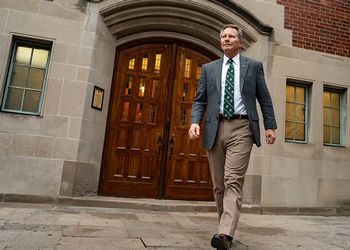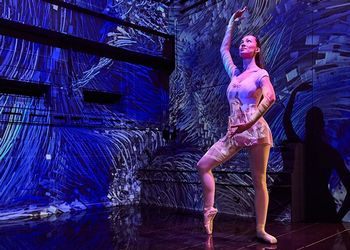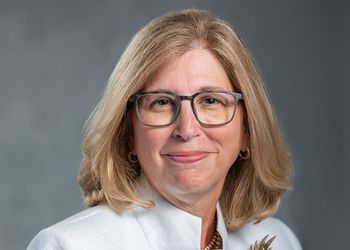Feature: Duckings, Stackings & Hops

DUCKINGS, STACKINGS & HOPS
As MSU metamorphosed into megaversity, the rigid social norms of early student life gradually gave way to a more relaxed lifestyle. During the mid-nineteenth century, the typical Michigan Agricultural College (present-day Michigan State University) student was unique -- he was attending the nation's first college devoted solely to the study of agriculture. Upon graduation, he would return to his rural community and become a leader in the industry on which the state's economy was based. While a student, he toiled in the college-owned fields for part of his education, and his leisure hours were defined by strictly observed social norms. He was expected to graduate with the manners and demeanor of a nineteenth-century gentleman. As the Lansing wilderness was gradually tamed, the MAC student's lifestyle metamorphosed into one of greater leisure and less formality.
By 1940, Michigan Agricultural College (MAC) had become Michigan State College (MSC) and the student was just as likely to be a woman studying for a degree in home economics. The typical student's social life was less regulated -- no one needed written permission to go canoeing or to spend an evening at the library -- but it was rigorously maintained by curfew restrictions and social expectations. How students occupied their time fifty, even one hundred, years ago provides a fascinating social barometer -- through it we can observe the ten-contemporary attitudes that reveal the changes in social norms and the inevitable similarities that crop up in each succeeding decade. It is the story of how the late nineteenth-century MAC 'Aggie' evolved into the pre-World War II MSC 'Spartan.'
Shortly after Michigan achieved statehood in 1837, the state legislature passed a law establishing a state university that was entitled to a congressional grant of nearly fifty thousand acres of land. Although located in Ann Arbor, the state university was directed to maintain branches in other areas of the state, where each would support 'a department of agriculture with competent instructors in the theory of agriculture, including vegetable physiology and agricultural chemistry, and experimental and practical farming and agriculture.' But the university lacked the proper funding to establish the branches, and founded preparatory schools instead, completely ignoring the mandate to teach its students agriculture.
In 1849 the State Agricultural society demanded something be done for the education of Michigan farmers. While the michigan Constitution empowered the legislature to establish a school of agriculture as a branch of the university of michigan, most farm leaders wanted a separate college. After several years, a legislative act was approved on 12 February 1855, to create the michigan Agricultural College on a site located within ten miles of Lansing.
College hall, the first campus building, was completed in 1857 and in May of that year classes began for sixty-three students. Other buildings followed as the students helped clear the land, construct the college's physical plant and maintain the vast farms for wages of up to eight cents an hour. Their work was part of MAC's Mandatory Labor Program, one that was common to colleges across the United States and helped students pay for their schooling.
The field work was also considered such valuable experience that it received top priority in the daily schedule. After 5:30 a.m. chapel and 6:00 a.m. breakfast, the first group of overall-clad students reported to farm foreman Hiram Hodges for three hours of work. At. 9:30 a.m. the second group took over; the final group began at 1:30 p.m. In the spring, the students plowed, harrowed and planted the vegetables they would hoe and weed in the summer. In the fall, they gathered corn, squash, potatoes, carrots and beans for winter storage. The harvested vegetables went to the college kitchen for student meals. Other student-powered tasks included milking cows, caring for the college-owned horses and oxen, mail pickup in Lansing, firing the furnaces in the College Hall basement, splitting rails and digging deep ditches and laying tile to drain the remaining swampy areas around the small campus.
Students planted shrubs and trees and even bridged a creek that wound across the grounds to the ravine where the W.J. Beal Botanical Gardens are now located. During the winter months the work --and the money -- halted. Winter break extended from Thanksgiving to mid-March. The labor program also included the professors who worked with the students to create an educational experience from the labor at hand.
Some professors worked better with the students than others. Samuel Johnson, a professor of agriculture, viewed his students as an expensive labor force for whom he had no patience. Instructed by the board to maintain 'an efficient and orderly farm' for MAC, Johnson sometimes docked students' wages when he felt they were not working hard enough. This action aroused considerable hostilities against Johnson, who was often the butt of many student pranks. He arrived at class one day to find the door locked and hardened plaster of Paris sealing the keyhole. Students frequently interrupted his lectures with prolonged laughter or by scraping their feet on matches. One student was suspended for drawing an 'irreverent' sketch of Johnson in his notebook. At the end of the term in 1886, the student's classmates built a bonfire with their notebooks on Professor Johnson's front lawn.
The students held other professors in higher regard. Dr. Manly Miles, dressed in brown overalls, was often found in the mud of a ditch or the barnyard muck with his students, demonstrating techniques and showing them how to conduct experiments using control fields or animals to maintain useful, accurate research. After work was over students desperately fought boredom during their leisure hours. Because of MAC's isolation, its students' social life was essentially nonexistent. Games and practical jokes became a common pastime.
In Michigan State: The First Hundred Years, author/historian Madison Kuhn tells how 'barrels filled with iron wedges rolled mysteriously down dormitory stairs late at night, and once, the steward's buggy was found atop the barn. The bell that hung from an oak between buildings might be upturned and filled with water to shower the sleepy student whose duty it was to wake the college. Filled with water and snow on a winter night, the bell would swing silently in the cold air of morning.' Saturday nights were filled with letter-writing, music and the occasional raid on the kitchen or a neighboring farm. An extra pair of overalls, fashioned into an impromptu grocery bag by tying the legs into knots, were filled with apples, cherries, watermelon or other seasonal treats.
By 1878 attendance at MAC exceeded two hundred students; by 1900 the total enrollment had tripled to over six hundred students. Because of the small enrollment, professors were well-acquainted with -- and usually respected by -- their students. The college president also maintained close ties with the student body. One of MAC's first presidents, Theophilus C. Abbot, believed so earnestly in his students' essential goodness that they constantly endeavored to justify his trust. A visiting college president from the East noted in a report: 'There seems to exist a kind and friendly relation between teachers and pupils. . .quite different from that state of hostility which seems the normal condition at ordinary colleges. It is due mainly, no doubt, to the good judgement of the officers, and their kind, familiar intercourse with the students.'
Due to the lack of a permanently appointed minister on campus, President Abbot often delivered the Sunday sermons.



